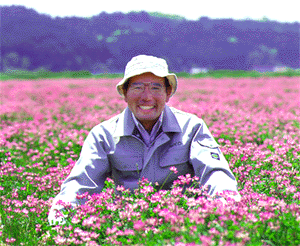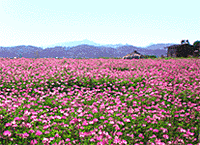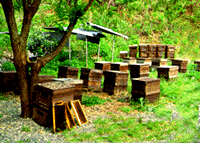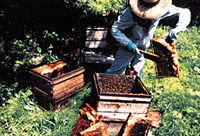|
1. The Environment
First
of all I would like to introduce you to Kagamino Town, the place
where the Yamada Bee Farm, our work place is located. Kagamino
Town is located at the foot of the Chugoku Mountains. To the north,
you can see the 1,000 meter high Izumiyama rising up in the sky.
When you go down along the valley where the Kagami River flows,
in the surroundings of Ichiba, the land becomes flat. At the verge
of the Mimasaka Basin in Okayama Prefecture, the river flows through
the town and merges into the Yoshii River, one of the three biggest
rivers of Okayama. Here you will find a typical countryside with
high mountains, low villages, crystal streams with fireflies,
and large fields where pink clover (Chinese milk vetch) flowers
blooms in spring. The Yamada Bee Farm has been split up between
several different locations in Kagamino, where nature still remains,
and has established bee farms there.
What is the first thing a beekeeper has to think about when he wants to set up a new bee farm? The first thing to think about is whether or not there are flowers which give ample honey that will serve as food for the honeybees. Places with flowers that provide honey and pollen from early spring till late autumn are the best. This doesn't mean that you have to worry when there are no flowers nearby. Honeybees normally fly within a radius of about 2 kilometers, which is about the same as a territory of 1,250 hectares. At our bee farm, Japanese apricots and cherry trees bloom in the spring, grape blossoms and l pink clover (Chinese milk vetch) flowers bloom at the river shore and farmers have also planted persimmon and chestnut trees, and grow pumpkins and sunflowers. In the mountains nearby, the various trees are blossoming. Based on the amount of flowers, we decide how many beehives we will put in one place. We put the beehives so that the honeybees will not hinder each other. Twenty beehives here, thirty beehives there, and some fifty beehives at places with many honey-producing plants and flowers.
|
|
|
|
|
|
2. Coniferous (Needle-leafed) Trees and Broad-leafed Trees
Artificial forests consist almost entirely of cedars and cypresses. These coniferous forests can also be found in some parts of Kagamino. It is impossible to set up a bee farm at such places. The honeybees cannot get their necessary nutrition because coniferous trees like cedars, cypresses and pine trees don't provide any honey (although they do blossom.) Cedars scatter around pollen that cause pollinosis (cedar pollen hay fever), but these are wind-pollinated flowers that don't need to be pollinated by insects.
On the world vegetation map, Japan belongs to the broad-leafed forest zone. This means that Japan was originally covered by broad-leafed trees like beech trees and several types of oak trees. In those kinds of broad-leafed tree forests, all kinds of animals, plants and flowers exist, and honeybees can get their pollen and honey. Mountain flowers that provide honey are small and don't stand out. In many cases their colors are somewhat subdued as well.
|
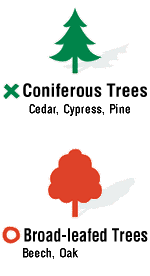 |
|

![]()
